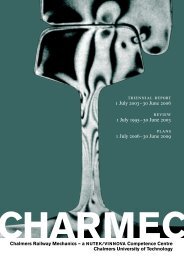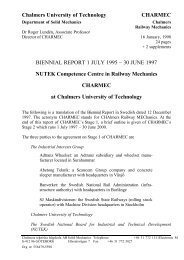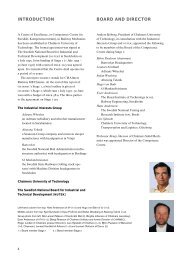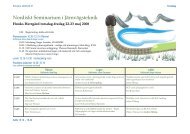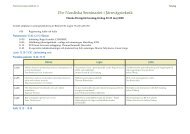You also want an ePaper? Increase the reach of your titles
YUMPU automatically turns print PDFs into web optimized ePapers that Google loves.
Materials and maintenance – Material och underhåll (MU) – Werkstoff und Unterhalt – Matériaux et entretienMU5. MECHANICAL PROPERTIES OF CONCRETE SLEEPERSMekaniska egenskaper hos betongsliprarMechanische Eigenschaften von BetonschwellenPropriétés mécaniques de traverses en bétonProject leaderand supervisorProfessor Kent Gylltoft,Structural Engineering/Concrete StructuresDoctoral candidate Mr Rikard Gustavson(now Rikard Bolmsvik)(from 1997-12-01;Lic Eng May 2000;PhD November 2002)Period 1997-07-01 – 2002-12-30Chalmers budget Stage 2: ksek 2000(excluding university Stage 3: ksek 1625basic resources)Industrial interests Stage 2: ksek 600+100in-kind budget (Abetong Teknik+Banverket)Stage 3: ksek 150(Abetong Teknik)The mu5 project has aimed at developing methodsfor the analysis and dimensioning of concrete sleeperssubjected to both static and dynamic loads. RikardGustavson successfully defended his doctoral dissertation(see below) in public on 7 November 2002. Thefaculty-appointed external examiner was Dr Jens JacobJensen of sintef Civil and Environmental Engineeringin Trondheim, Norway. Since December 2002, RikardGustavson (Bolmsvik) has been employed by AbetongTeknik in Växjö.Extensive laboratory experiments with small specimenswere carried out to clarify the bonding (adhesionand friction) between strands (tendons) and concrete ina prestressed sleeper. It was found that adhesion was themain bonding mechanism in the initial phase. A changeof the strand surface or the concrete recipe that increasesadhesion will thus largely improve the anchorage of theprestressing force during prestressing release in sleepermanufacturing. Full-scale laboratory tests on sleepersshowed how different strand designs affect both the prestressingprocess during the production of sleepers andthe response (deformation, crushing and cracking) whenthe sleepers are submitted to increased loading.A three-dimensional bonding model for the prestressedstrands has been incorporated in the general computerprogram diana for concrete structures. Use of the femethod (non-linear and three-dimensional) enabled detailedstudies revealing how differing design parametersinfluence the behaviour of a concrete sleeper when installedin the track. In these studies, the computer programdiff (see under project ts1) was used to generatethe operational loading on the sleeper.An updated research plan dated 2000-09-13 was approvedby the charmec Board on 21 September 2000.Collaboration with Abetong Teknik has been close. Seefurther the charmec <strong>Triennial</strong> <strong>Report</strong> from Stage 2.Rikard Gustavson and Kent Gylltoft: Static and dynamicresponse of concrete sleepers, Nordic Concrete Research,vol 2/00, 2000, pp 49-66Rikard Gustavson: Steel-encased pull-through and push-intests of indented three-wire strands, <strong>Report</strong> 01:2, ChalmersConcrete Structures, Gothenburg March 2001, 183 ppRikard Gustavson: Pull-through test of strands with varioussurface treatments and geometries, <strong>Report</strong> 01:6, ChalmersConcrete Structures, Gothenburg June 2001, 33 ppPhD student Rikard Gustavson (left) and his supervisor ProfessorKent Gylltoft in project MU5. Photo taken 2000 in the laboratory ofChalmers Concrete EngineeringKarin Lundgren and Rikard Gustavson: Examining bond bya combination of numerical modelling and tests, Proceedings18th Symposium on Nordic Concrete Research, Elsinore(Denmark) June 2002, pp 63-6534



